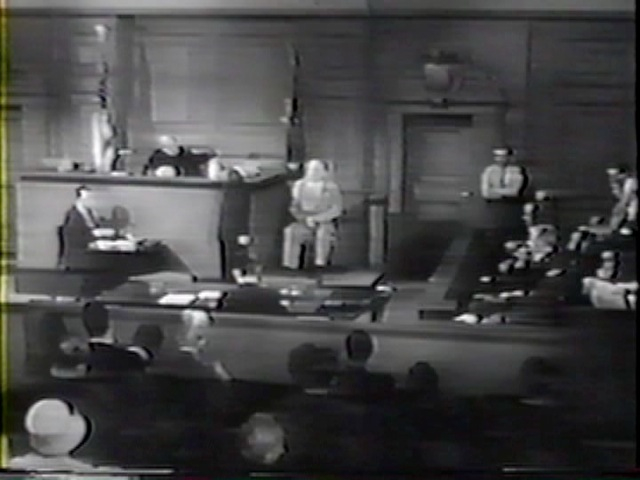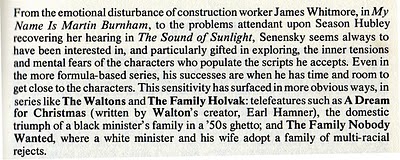Filmed June 1963
Because the original pilot for ARREST AND TRIAL was scrapped, the first show of the new series to go into production, MY NAME IS MARTIN BURNHAM, in a sense was almost another pilot, similar to NARCISSUS ON AN OLD RED FIRE ENGINE on ROUTE 66, which had been presenting a new co-star in hopes of getting a renewal for that series. One big difference between the two, ARREST AND TRIAL had a nine day shooting schedule for a ninety minute film; ROUTE 66 took ten days to film a sixty minute film. The economical approach to things went beyond the scheduling. Every set for all films had a craft services table; coffee, tea and doughnuts were available for cast and crew for the entire day. As the beginning of the new season for 1963-64 began, someone in the black tower at Universal decided that service was not only an expense that could be cut, it could actually be turned into a small profit making venture. Therefore no longer would these items be given away; cast and crew would have to pay for them. This lasted exactly one day. Chuck Connors to his credit sided with the crew and voiced a strenuous objection, and if there was one thing that could make a black suit fade, it was an unhappy star. As of the second day coffee, tea and doughnuts again were complimentary.
All of our sets were designed based on the Los Angeles Police Department complex, and in my prep period I had spent a day at the complex learning their procedures. When I was staging the first sequence in the section where prisoners conferred with their lawyers, producer Frank Rosenberg came onto the set.
“Why are you doing that scene here?” he asked.
My answer was, “Because that’s where they would be meeting”
Frank just shook his head. “It doesn’t look real. All those people listening to what they’re saying.”
I asked him, “Well, where do you think it should be staged?”
“In Martin’s jail cell,” he responded.
“But this is the way it’s done,” I said. “Look, once they’re in position, the coverage will be in over the shoulders and closeups. I’ll be sure not to have anybody in the background of any of those shots.”
That seemed to satisfy Frank, and he didn’t make me change my staging. But the show that aired the week following MY NAME IS MARTIN BURNHAM, had a prisoner talking to his lawyer — where else — in the prisoner’s jail cell.
A possible flaw was included in the original concept for ARREST AND TRIAL that could have been avoided if they had planned for the lawyer in the trial section of the drama to be the district attorney. Then both the detective who made the arrest and the attorney who prosecuted would have been working on the same side. But that’s not the way it was created.
A situation had been created where if the attorney defending the prisoner won the case and set his client free, the detective had arrested the wrong man; but if the defendant was found guilty, the detective had arrested the right man and the attorney was the loser of the week. That was the situation created by the original concept for this series. It took some careful fleet of foot maneuvering weekly to navigate through those treacherous waters.
On the ROUTE 66 episode, IN THE CLOSING OF A TRUNK, I had seen Ruth Roman use a unique way to prepare for an emotional scene; she snapped a smelling salts (ammonia) capsule in a handkerchief and then took a couple of quick whiffs of it. Oh the stupidity of young directors. Nina Foch had a very emotional scene to do with Jimmy Whitmore. Trying-to-be-helpful-me (and probably wanting to show off how knowledgeable I was about acting) I suggested to her that we could get some ammonia capsules to help her. It’s amazing she didn’t deck me. How dare I question her ability to generate tears without any helpful suggestions from me! But just because I had thrown down that gauntlet, for a couple of takes, Nina COULDN’T produce the tears. But pro that she was, they did come. And boy did I learn a valuable lesson! Just keep your big mouth shut!
The courtroom was a brand new set, designs based on the new courtrooms in downtown Los Angeles. And I was going to be the first one to film in it. What would be the normal protocol in filming such a set? Get a beautiful wide establishing shot from the rear of the courtroom facing the judge’s bench.

So I requested that the rear wall be removed so that we could get my first shot. Normally that would be no problem. The walls of sets were always divided into sections and then attached to braces that permitted them to be rolled in and out with ease. BUT NOT THAT DAY! When that set was put together, someone must have thought it was going to be photographed like a live location. It had been nailed together so that nothing moved. It took an eternity before sections of it could be dismantled, braced and moved so that filming could resume.
Richard Eyer, the young Burnham son, Jerry, started acting when he was seven years old. When he was eleven he played Gary Cooper’s son in FRIENDLY PERSUASION. Remember him being chased by the goose? At the time of this production he was an old Hollywood pro of eighteen; he turned eighteen twenty-five days before this production began filming. This was his first production when he didn’t have to go to school at the studio, and when he didn’t have to have a parent accompany him to the set.
When we did this film, at the age of eighteen Richard Eyer had appeared in over ninety feature films or television shows. This was my twelfth.
In 1979 a book was published in England about American Directors in Television.

In writing about me these authors across the pond said better than I can where I’ve always tried to go as a director.

The clerk of the court who swears in Martin is Tom Palmer. Tom and his wife were two of my closest friends. Tom was Canadian and had made a success on Broadway as a member of the Alfred Lunt-Lynn Fontanne company. To them he was their ‘Tommy’. Tom later became a leading casting director in Hollywood. He was one of many actors who ended up casting. And they were the best. They loved actors; they knew actors; they could recognize talent. To name a few: Bert Remsen, John Conwell, Dodie McClean, Jim Merrick.
After the filming was completed, I worked with the film editor on my director’s cut. The show was then turned over to the producer. Once the film was completed there was an answer print screening which I attended. I walked out of the screening room after the death of Latham sequence. I was very disturbed by what I had just witnessed. I felt the scene had been very badly reedited, and what should have been a strong climactic ending to the Arrest part of the story missed that goal by a very wide margin. I realized in leaving I was probably burning a bridge to future employment, but at that moment I didn’t care.
The journey continues



I found this series very entertaining and bold to extend beyond the normal one hour TV fare. I recently purchased the boxed set and noticed that these were salvaged just in the nick of time. They have held up extremely well given the age, but a more comprehensive set should have been assembled with a little cleaning-up. Sadly this episode is missing from the boxed set too. All the same, thanks for sharing your memories and insightful comments from one of the better episodes from this series.
As a keen observer of Universal Studios’ business practices, you might find this story amusing:
Earlier this year, I was watching an episode of ‘McMillan and Wife’ on the COZI-TV channel (which is 90%+ programs from Universal) called “Cop of the Year”. It was originally broadcast on Nov. 19, 1972.
There was a scene where Mac (Rock Hudson) flies down to a Hollywood studio to do research. He walks onto a western street where two gunslingers have a quick draw. Then he meets the director, George Seaton, who says he’s filming his latest picture, called “Showdown”. Mac wants to know how a shooting can be faked. Seaton refers him to his special effects guy (played by William Bramley!).
After the show, I wondered if George Seaton was a real person, so I looked him up in IMDB. Whoa, how did I not know that he was the guiding genius behind “Miracle on Thirty-Fourth Street”?! Some more interesting facts: the last movie Seaton directed was released in June, 1973…it was called “Showdown”…it was produced by Universal…and it starred Rock Hudson!